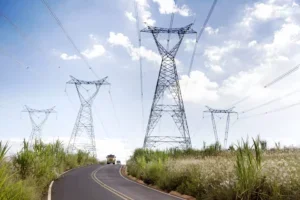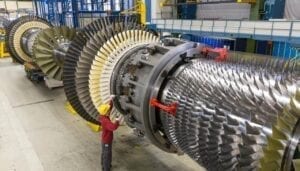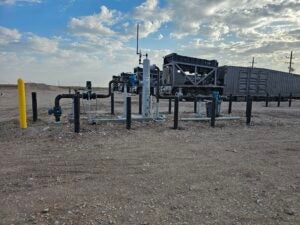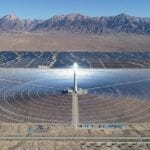One of the world’s first molten salt tower concentrated solar power (CSP) projects that uses a “Stellio” heliostat was grid-connected at the end of December in China’s Xinjiang province near the Mongolian border. The 50-MW Hami pilot project developed by Chinese state-owned company China Power Engineering Consulting Group marks a major milestone for the novel heliostat design, which went from concept to construction in a mere five years.
The $226 million Hami project is a central receiver plant that uses molten salts as heat transfer fluid and as a thermal storage system. According to its developer, the project operates with a 43% thermal efficiency under ambient temperatures of 19C, and an air condenser backpressure of 8.5 kPa. When in operation, the thermal efficiency of the thermal storage and heat transfer system reaches 99%—which means the 1,430 MWh storage system can run the turbine at full output for 12 hours.
The Hami project, which was built in roughly two years, is China’s sixth large-scale commercial solar thermal power project, according to the China Solar Thermal Alliance, and it brings the country’s total CSP capacity to 350 MW. However, development of its innovative heliostat began much earlier.
According to a recent paper authored by experts involved in the Hami project, the design concept took shape when German structural engineering and consulting firm Schlaich Bergermann Partner (sbp) set out to address an increasing interest in solar tower technology in 2010. The firm partnered with South Africa’s SASOL Technology to further develop its design, and the partners eventually settled on calling it “Stellio,” a name that refers to a sun-loving agama lizard.
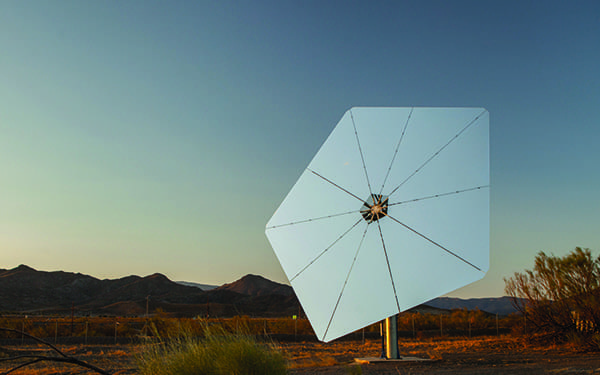 |
|
2. The Stellio heliostat developed by German firm sbp sonne in collaboration with partners Ingemetal and Masermic features a new axis arrangement. It allows the use of cost-efficient linear actuators for both axes, providing a cost-effective pentagonal structure. Courtesy: sbp sonne gmbh |
When SASOL withdrew from renewables to focus on its chemicals business, sbp joined forces with Spanish CSP experts Ingemetal Energias and Masermic. The companies built the first Stellio prototype (Figure 2) at the Plataforma Solar de Almería in Spain in 2014, equipping it with sensors. That project, sbp said, confirmed and allowed for verification of Stellio’s “outstanding optical and tracking performance.” At least four other prototypes were also tested, each building on lessons learned.
However, the consortium’s initial efforts to build a first-of-its-kind plant at Redstone in South Africa’s Northern Cape Region collapsed, so it collaborated with Dongfang Boiler Group (DBC), and eventually won a tender in 2016 to build a project at the Hami solar field. As sbp notes, Stellio was especially attractive even then; it won the SolarPACES Technology Innovation Award 2015 and the CSP PLAZA Technology Innovation Award 2017.
Its winning attribute is its pentagonal design, which greatly reduces the subtle but ongoing oscillation from wind load. The design essentially comprises 10 cantilever arms and a central hub, which allows for “a more homogenous stiffness distribution compared to rectangular structures and results in a very efficient structural system, [that is], it provides low deformations and thus high optical performance at low specific weight. Its roundish shape reduces shading and blocking and allows for a compact field layout,” the firm explained.
However, the design is also partly derived from well-proven parabolic trough technology. “The cantilever arm [is] welded from hollow box sections—easy to fabricate and with optimum stiffness per weight.” It also features five rings of purlins that carry the mirrors; the purlins are made from a cost-effective sheet metal. The hub and the parts of the kinematic system are welded from plates.
“The main advantage of the Stellio kinematic system with two inclined axes is that cost-efficient linear actuators can be used for both axes and that tracking errors due to drive backlash are eliminated for [most] heliostat orientations,” sbp added.
The whole structure is then hot dip galvanized to ensure long-term corrosion protection. Finally, it uses 10 mirrors (made from 4-millimeter-thick float glass) as well as a central mirror—which altogether form a 48.5-square-meter reflecting surface. The Hami solar field turned out to be ideally suited to the Stellio design because it features a “slight overall slope” that lends well to a staggered field configuration. The field surrounding the 200-meter-high solar tower can host 14,500 heliostats. So far, “Thousands of heliostats have been installed and the field commissioning is under way. The receiver has been mounted on top of the tower,” Fabian Gross, an sbp engineer and physicist, told POWER on March 2.
According to SolarPACES, the International Energy Agency’s CSP research arm, how quickly the concept progressed from “lab to commercial” is remarkable. “The biggest obstacle to advancing potential cost-cutting improvements in novel CSP technologies is getting them deployed in commercial projects. Risks are high when every CSP plant must be built at utility-scale and must make money right away,” it noted. However, the project also benefited greatly from being built in China, which as Solar PACES noted, “takes a different approach to new technologies that favors giving novel designs a tryout. Its first CSP projects are demonstration projects, yet they are being built at full size to allow real-life engineering issues to show up so they can be resolved at commercial scale.”
The 50-MW Yumen project in China, for example, is testing a “beam-down” dish CSP, a technology that promises to cut CSP power costs by 30%. “If beam down works, it could greatly simplify solar hydrogen thermochemistry, because a focal point on the ground is conducive to another innovation to cut renewable hydrogen costs by combining the solar receiver/reactor with thermal storage at ground level, where the thermochemistry for splitting water is best carried out,” the organization noted. Another phase of the Yumen project is also testing a silicon-based heat transfer fluid (HTF) for trough CSP in a project spearheaded by Chinese firm Royal Tech CSP, another SolarPACES award winner. That’s notable because “Silicon can get much hotter than today’s 400C standard heat transfer fluid for trough CSP, so this Si-HTF greatly improves the efficiency of parabolic trough CSP,” SolarPACES said.
—Sonal Patel is a POWER senior associate editor.
Correction: This version corrects the height of the solar tower, which stands at 200 meters, not 94 meters.




